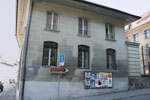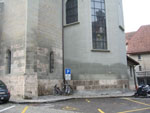2011 – Matthieu Fuscien, MAS student in Conservation of cultural heritage (UNIGE) has completed the work experience for his diploma in our laboratory. He has studied humid patches that are visible on numerous historic buildings. This study, based on one hand on case studies from the city of Fribourg and on the other hand on an experimental approach, has allowed to show once again that the presence of hygroscopic salts (chlorides, nitrates) within the construction materials can explain on its own the existence of these patches (see our archived tricks).
The experimental part of the study has shown that if the materials of a building are polluted with hygroscopic salts and if the ambient relative humidity remains regularly on a high level, liquid water (qualified as capillary water) can appear and persist within the porosity of the materials as a consequence of diurnal temperature variations, as a consequence of a simple absorption of ambient water vapour.
The report, at the moment in the correction phase, will soon e accessible here. In the mean time, some extracts can be consulted :
Buildings studied in Fribourg :



Some extracts from the experimental part see our French page “taches humides”